History
To symbolize the union and centralization of political power of the Hispanic Monarchy, in 1561 Philip II chose, almost simultaneously, Madrid as the capital of the Kingdom of Spain and the hillside of Abantos, a mount in Sierra de Guadarrama, to construct a Hieronymite Monastery, el Monasterio de San Lorenzo El Real, also known as Monasterio del Escorial, or El Escorial: the monastery receives its name from the municipality of El Escorial. Furthermore, the king commissioned Juan Bautista de Toledo to build a Royal Park at La Fresneda, then a village, at the foothills of Abantos and Las Machotas, near the small village of El Escorial (equidistant of both, el Monasterio and La Granjilla).
La Granjilla was designed by Juan Bautista de Toledo as homologous, but conceptually opposed, to the Monastery of El Escorial. Other collaborators in the project were Gaspar de Vega, Juan de Herrera, Pedro de Tolosa, fray Marcos de Cardona and Petri Jansen.
Description
Located at the foothills of the Sierra de Guadarrama, La Granjilla de La Fresneda is a multifunctional architectural complex including ornamental, ethnobotanical and spagyric gardens, artificial dams and waterways, and a hunting reserve. The different sections of the Royal Park are separated by dry stone walls.
Fray Marcos de Cardona, a Hieronymite monk, was the designer and gardener of the Royal Gardens. Dutch hydraulic expert, Petre Janson, oversaw the creation of the five Royal Lakes. Both the monk and pond expert were working under the directions of Philip II and Juan Bautista de Toledo.
The highest and largest pond receives water from the Aulencia river. This pond provides water to the other three artificial lakes and to the whole complex through a system of dams, waterways and conduits--a unique and inspired hydraulic archeology from the Spanish Renaissance.
The Royal Gardens in La Granjilla de La Fresneda and the Gardens of El Escorial (La Huerta del Monasterio) are very peculiar and unique Spanish Renaissance royal gardens; both of them were hybrids of ornamental gardens, market gardens, ethnobotanical garden and spagyric garden. Its relevance is obvious in the context of previous historical royal gardens and royal cottages, such as the gardens of the Chateau de Chambord of Francis I.
La Granjilla de La Fresneda won the International Carlo Scarpa Award from the Benetton Foundation, for the management and conservation of Historical Gardens.
La Casa de Campo de Madrid, La Granjilla de La Fresneda del Escorial and El Canal del Escorial (built to supply water to the Monastery) and La Cacera de La Granjilla de La Fresneda (the aqueduct to feed the ponds of La Granjilla, from the Aulencia river) were designed by Juan Bautista de Toledo and Juan de Herrera. These civil engineering works were part of an extensive network of hydraulic, environmental and infrastructural transformations stretching out from Madrid to the slopes of Abantos and mountain-tops of Santa María de la Alameda, the starting point for El Canal del Escorial, the catchment area of the Alberche river.

Louis I was King of Spain from 15 January 1724 until his death in August the same year. His reign is one of the shortest in history, lasting for just over seven months.

El Escorial, or the Royal Site of San Lorenzo de El Escorial, or Monasterio de El Escorial, is a historical residence of the King of Spain located in the town of San Lorenzo de El Escorial, 2.06 kilometres (1.28 mi) up the valley from the town of El Escorial and about 45 kilometres (28 mi) northwest of the Spanish capital Madrid. Built between 1563 and 1584 by order of King Philip II, El Escorial is the largest Renaissance building in the world. It is one of the Spanish royal sites and functions as a monastery, basilica, royal palace, pantheon, library, museum, university, school, and hospital.

San Lorenzo de El Escorial, also known as El Escorial de Arriba, is a town and municipality in the Community of Madrid, Spain, located to the northwest of the region in the southeastern side of the Sierra de Guadarrama, at the foot of Mount Abantos and Las Machotas, 47 kilometres (29 mi) from Madrid. It is head of the eponymous judicial party. The settlement is popularly called El Escorial de Arriba, to differentiate it from the neighbouring village of El Escorial, also known as El Escorial de Abajo.

El Escorial is a municipality in the Autonomous Community of Madrid, located 45 km (28 mi) northwest of the Spanish capital Madrid. It belongs to the comarca of Cuenca del Guadarrama. Its population in 2009 was 14,979.

The Spanish Golden Age was a period of flourishing in arts and literature in Spain, coinciding with the political rise of the Spanish Empire under the Catholic Monarchs of Spain and the Spanish Habsburgs. The greatest patron of Spanish art and culture during this period was King Philip II (1556–1598). His royal palace, El Escorial, invited the attention of some of Europe's greatest architects and painters, such as El Greco, who infused Spanish art with foreign styles and helped create a uniquely Spanish style of painting. The period is associated with the reigns of Isabella I, Ferdinand II, Charles V, Philip II, Philip III, and Philip IV, when Spain was at the peak of its power and influence in Europe and the world.

Juan de Herrera was a Spanish architect, mathematician and geometrician.
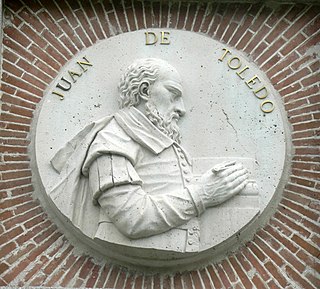
Juan Bautista de Toledo was a Spanish architect. He was educated in Italy, in the Italian High Renaissance. As many Italian renaissance architects, he had experience in both architecture and military and civil public works. Born, either in Toledo or in Madrid around 1515. He died on 19 May 1567 in Madrid, and was buried in Madrid in the choir of the primitive “Convento de Santo Tomás, Iglesia de la Santa Cruz”.
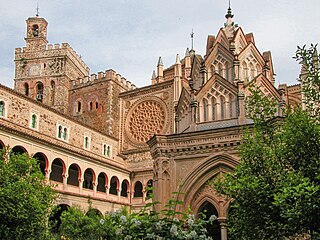
The Royal Monastery of Saint Mary of Guadalupe is a Roman Catholic monastic establishment built during the 14th century located in Guadalupe, in Extremadura, Spain. It is located at the foot of the eastern side of the Sierra de las Villuercas and was one of the most important and fine monasteries in the country for more than four centuries. UNESCO declared it a World Heritage Site in 1993.

Spanish Renaissance architecture was that style of Renaissance architecture in the last decades of the 15th century. Renaissance evolved firstly in Florence and then Rome and other parts of the Italian Peninsula as the result of Renaissance humanism and a revived interest in Classical architecture. In Spain, the Renaissance began to be grafted to Gothic forms as mathematicians and engineers rediscovered building as one of the technological sciences. In the time of King Felipe II (1556–1589), the Renaissance influence expanded throughout the territory thanks to the dissemination of architectural treatises.

Friar Juan Bautista Maíno, or Mayno was a Spanish Baroque painter.
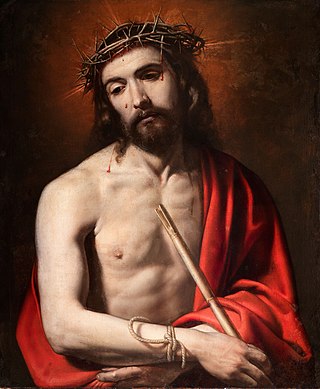
Antonio Fernández Arias was a Spanish painter of the Baroque period.

The Herrerian style of architecture was developed in Spain during the last third of the 16th century under the reign of Philip II (1556–1598), and continued in force in the 17th century, but transformed by the Baroque style of the time. It corresponds to the third and final stage of Spanish Renaissance architecture, whose dominant trend had been towards austerity and minimal decoration. The ornate Plateresque style had given way to classical Purism in the second third of the 16th century. Purism in turn had given way to the geometric simplicity of the Herrerian style.

The Monastery of Santa Maria de la Murta is a former monastery of the order of the Hieronymites located in the Valley of La Murta in Alzira (Valencia), Spain.

José Gómez de Navia was a Spanish engraver and draftsman.

Margarita of Spain was an infanta of Spain, who died in childhood.
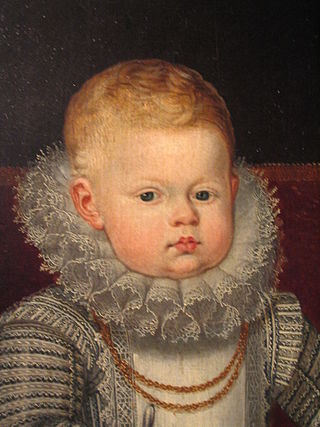
Alonso of Spain was an infante of Spain, who died in childhood.
La princesa de Éboli is a two-part Spanish period drama television miniseries about the woman of the same name. Directed by Belén Macías and starring Belén Rueda, Hugo Silva and Eduard Fernández, it originally aired in October 2010 on Antena 3.
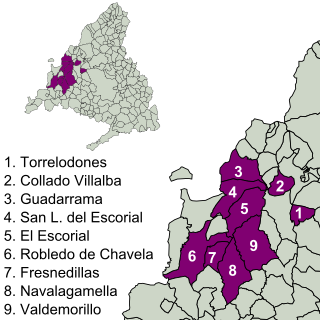
The Imperial Route of the Community of Madrid is the tourist itinerary promoted by the Ministry of Culture and Tourism of this Spanish region, which runs through several municipalities in the Sierra de Guadarrama. It partially follows the historical road that led to the Monastery of El Escorial, used in the 16th century by King Philip II in his travels from the city of Madrid to the Royal Site.

The Library of the Monastery of San Lorenzo de El Escorial, also known as theEscurialense or theLaurentina, is a large Spanish Renaissance library founded by Philip II, located in San Lorenzo de El Escorial and part of the heritage of the monastery of El Escorial.
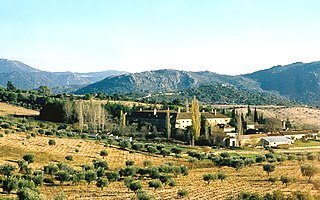
The El Quexigal Palace is a renaissance palace near Cebreros in the province of Ávila, Spain. It was constructed in 1563 during the reign of king Philip II of Spain. It was intended as a farm and a hunting lodge for the royal family, who often staid at the nearby royal site of the El Escorial. The design is by the Juan de Herrera. In the 20th century, the Hohenlohe family owned the estate. In 2023, renovations started in order to use it as a luxury hotel.



















